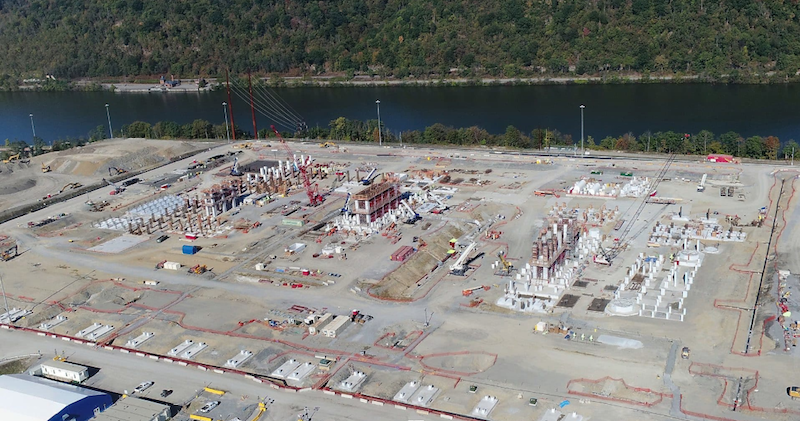A large petrochemicals plant under construction along the Ohio River is providing some welcome new business for inland barging, as well as an economic boost to an area hit hard by declines in the manufacturing and coal industries.
Shell Chemical Appalachia LLC broke ground in 2017 on the $6 billion complex in Monaca, Pa., about 30 miles northwest of Pittsburgh. It is Shell’s first petrochemical plant built outside the Gulf Coast in decades. Construction has revved up this year, and just about all materials are being shipped by a combination of deck and open hopper barges along the Ohio River to the facility’s specially-constructed docks designed to receive barge shipments.
In June, New Orleans-based Canal Barge Company Inc. delivered a huge quench tower (a key component of the plant) that measured 300' long, roughly the size of a football field, and weighed some 2,000 tons. That delivery required some sophisticated planning by Canal Barge to accommodate such a large structure, and by authorities who closed a local bridge as a precaution while the barge passed below.
“The facility is being built modular, meaning that many components are built at fabrication facilities and then shipped to the site,” said Merritt Lane, president and CEO of Canal Barge. “Much of what we’re moving sources either internationally or from coastal ports that require oceangoing barges, (and is) equipment that will be used in the chemical manufacturing process.”
When finished, the facility will chemically “crack” or break apart ethane, an abundant natural gas sourced from the nearby Marcellus and Utica shale formations, and convert it to polyethylene plastic pellets. These are used to make a variety of items, such as food packaging, film, diapers, housewares, crates, bottles and automotive parts. Production is expected to begin in 2020.
Shell chose the Ohio River site (a former zinc smelting plant) because of its proximity to the natural gas supply and to its polyethylene customers. Nearby transportation links through the Ohio River, railroads and highways also played favorably in the decision, the company has said.
Although barges will not carry the finished products — those will move by truck and rail — barges will be in demand by the numerous manufacturing plants that are expected to spring up along the river to use the materials produced by the cracker, officials say.
“These secondary, downstream sites that will use the plastic materials to make other things may be an outbound barging opportunity,” said Peter Stephaich, chairman and CEO of Campbell Transportation Co., a Pittsburgh-based marine services company that operates on the Upper Ohio, adding that this new business could help fill the loss of business from the shrinking coal market in the region.
“This plant energizes the whole energy market for us,” said Mary Ann Bucci, director of the Port of Pittsburgh Commission. “We will see other companies wanting to provide raw materials or sell products as a third party. These companies will want to be here because Shell is here, and it will be good for the Port of Pittsburgh.”
By selecting the Ohio River location, Shell doesn’t appear to be concerned about the reliability of the river’s depression-era locks and dams.
The Port of Pittsburgh and the Waterways Council Inc. are hoping that the economic promise the plant represents and the need for reliable river transport to support it, will encourage the federal government to complete rehabilitation of the Upper Ohio River Lock and Dam system (defined as Emsworth, Dashields and Montgomery). That $2.3 billion project has been under consideration since 2003 and is now undergoing a third study. “A major failure on the Upper Ohio,” Bucci said, “would shut down the entire Port of Pittsburgh.”





